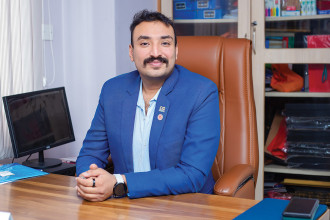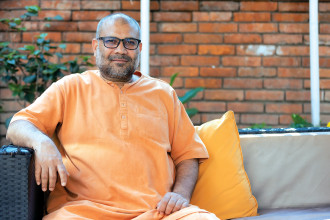-1709875790.jpg)
Phupu Chowang Sherpa
Managing Director of Arun Treks and Expeditions
Kangchenjunga is the third highest mountain in the world. It lies between the state of Sikkim in India and Taplejung district of eastern Nepal. The name Kangchenjunga has been derived from four Tibetan words – Gangs, Chen, Mzod, and Inga – which means ‘the five treasures of the mountains’.
Sherpa was born and raised in Gyabla, Taplejung – an area that in 2024 requires you to walk on moderately hard trail for two days from Phungling municipality. Phupu Chowang Sherpa is an individual who has worked hard to become the person he is – it took him the courage to walk the uncharted path of leaving home and family to build his fortune back in the 70s. His mission to make something of his life took him to Solukhumbu and that was where he found his calling in the world of Nepali tourism and hospitality.
Decades later and having travelled the world and built a moderate fortune, Sherpa returned home to Gyabla on a quest to give back to his birthplace the knowledge he had built. He wanted the scarce and often overlooked population of Kanchenjunga to witness and experience the comforts of the modern world and along with it, the prosperity of modern business and commerce.
He built his first hotel here and for weary trekkers and travellers who walk the hidden trails of Kanchenjunga Conservation Area, this place is a respite where you get warm food, clean bed and hot water. You also get the warm hospitality of Sherpa who treats you to the stories of the region over cups of impeccably brewed coffee and a concoction of coffee with homemade liquor that is his own unique recipe, if you are lucky.
He worries that Taplejung has not received the state attention as it should despite being a prosperous and rich region in water and minerals. He is concerned that modernisation may come in but at the cost of the indigenous groups who may be displaced from their homes and from the prosperity that should rightfully be theirs.
In conversation with Phupu Chowang Sherpa, a man who deeply loves the mountains, we delve into a few aspects of the potential of developing and promoting the Kanchenjunga Conservation Area in Taplejung for trekking and tourism. Excerpts:
What is the tourism potential of the Kanchenjunga area?
Though Kangchenjunga has the potential for trekking, not many people visit the area unlike the Everest and Annapurna regions. According to statistics of the Ministry of Culture, Tourism and Civil Aviation, a total of 858 people went to Kangchenjunga for trekking in 2022. The government has introduced certain rules and regulations like every trekker must have a trekking permit for the Kangchenjunga region. The rules and regulations made for adventurous activities change with changing time and needs. For Kangchenjunga, two permits are required – one is the Kanchenjunga Restricted Area Permit and the other is the Kangchenjunga Conservation Permit. Only authorised trekking agencies can apply for the Kangchenjunga trekking permit after submission of several documents from the Department of Immigration. The procedure to obtain a permit is lengthy and difficult. Contrast this with trekking in Annapurna Base Camp where we had close to 16,000 trekkers in 2022.
What are the highlights of trekking in Kanchenjunga and what is holding the region back in terms of tourism development?
A trek in the Kangchenjunga provides ample opportunities to experience the culture of the region. Local people residing in the area are from different ethnic groups such as Limbu, Rai and Sherpa with distinct languages, customs and cultures. Traditionally, the people of Kangchenjunga have been involved in agriculture, agroforestry, horticulture and animal husbandry, however ecotourism is gradually being adopted by the locals. Tourism businesses like homestays are also just starting.
Although new tourism concepts are evolving many people are reluctant to change and adapt to the new ways of economic involvement. The traditional way of thinking is deeply rooted and needs to be eradicated by creating awareness and setting up training facilities.
Tourism has always been associated with the economy. It is an undeniable fact that one of the main sources of income for countries with an import-based economy is tourism. Tourism directly impacts the GDP and living conditions of people. If we really want to uplift the people then tourism is the best option.
Back in 1984, when I went to Namche Bazaar it was not what it looks like today. And that was only possible as many locals started getting involved in ecotourism. When people are economically sound, then only can they think out of the box and do something creative.
As of today, 800 to 900 tourists visit the Kanchenjunga region on an annual basis and if we compare this to other places, we are way behind. We need the government and industry stakeholders to help build the tourism ecosystem for Kanchenjunga in a holistic way. The other aspect lacking for the Kanchenjunga region is promotion and advertising. There is an abundance of travel bloggers and vloggers in Nepal, who are great resources for the nation when it comes to making destinations visible, however, very few attempts have been made in the Kanchenjunga region. We have an airport in Phungling but flights are not regular. People lose many days in travel just to get here. The government remains apathetic when it comes to tourism promotion. It is really disheartening,
What are the possibilities in your opinion?
The Kangchenjunga Conservation Area is beautiful. We can build and promote high-value trekking and adventure related tourism. But development must create opportunities for those who reside within the conservation area. Various committees have been established among the villagers who are responsible for the rationale use and conservation of resources. It is difficult to survive inside a conservation area, but we must see this as great opportunity for people to learn about sustainability.
Rightly done, it will create jobs, enhance the value of the property, increase exports, expand local businesses, attract new or relocate businesses, increase tax revenues, and more.
I started a hotel in Gyabla. Later, I invested in two more hotels, I also have a yak farm in Lelep, Ghunsa. The reason why I am doing this at my age is to set an example for others and encourage them to start something that promotes their identity and culture. Yak farm is our traditional business which most people have already forgotten.
Many people ignore the available opportunities and have started migrating to foreign lands. I hope to serve as an inspiration to those who have lost hope and are unable to uplift from their living conditions.






